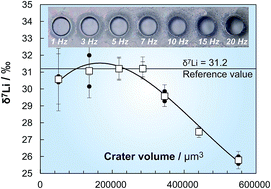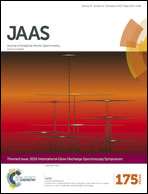Influence of laser parameters on isotope fractionation and optimisation of lithium and boron isotope ratio measurements using laser ablation-multiple Faraday collector-inductively coupled plasma mass spectrometry†
Abstract
We report the origin of isotope fractionation induced by the choice of laser parameters and a method for accurate in situ determination of lithium (δ7Li) and boron (δ11B) isotope ratios in glasses and minerals using laser ablation multiple Faraday collector inductively coupled plasma mass spectrometry (LA-MFC-ICPMS). Laser ablation parameters were examined using 266 nm femtosecond (266FsLA) and 193 nm nanosecond excimer (193ExLA) laser ablation systems for crater diameters of 30–200 μm. We found that higher laser repetition rates and larger crater diameters have led to enhanced fractionation of lighter isotopes, as much as −8‰ for both δ7Li and δ11B. Fractionation was primarily affected by the ICP aerosol loading and secondly by the thermal fractionation at the LA site. The former was accounted for by mass loading effects, which lowered the plasma temperature and led to insufficient aerosol vaporisation. The latter was related to the molten layer on the crater walls, which resulted in coarser and heavier δ7Li and δ11B aerosols that did not reach the ICP. Both processes can result in Rayleigh fractionation during aerosol formation and vaporisation. Controlled ablation using a constant crater size, repetition rate, and high laser fluence of 193ExLA enabled reproducible ablation for the standard NIST SRM 61X glasses and unknown basalt glasses. Based on the principles of isotopic fractionation deduced from our experiments, we propose a novel ablation volume correction (AVC) protocol for accurate isotopic analyses of various samples with different matrices. Both the repeatability and the laboratory bias of the δ7Li and δ11B measurements using the new AVC protocol were better than 1‰ for samples containing a few tens to a few tens of thousands ppm Li and B. We also report significant local heterogeneity of up to several ‰ found in some basalt glasses, but not in NIST SRM 612 and 610.


 Please wait while we load your content...
Please wait while we load your content...